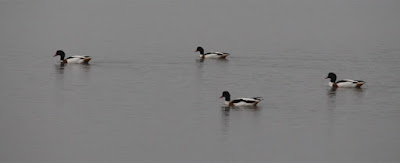 |
| Brent goose, Meols |
I thought I'd start the week with a trip to the seaside, doing the usual walk between Leasowe and Hoylake and seeing where I got to after that. The day started cloudy with occasional hints of sunshine but settled into one of those overcast November days where everything that isn't cerulean blue and grey is in shades of rose gold.
The feeders in the back garden were busy with spadgers as I left home and the gulls were slowly drifting onto the school playing field. As I waited for my train at Humphrey Park I was serenaded by the calls of a large skein of pink-footed geese overhead.
The journey over to Liverpool renewed my worries about woodpigeons. For all that huge flocks are being reported migrating at dawn there doesn't to be many hanging round in their usual haunts. On a journey like this records of ones or twos of woodpigeons would join the dots between the places busy with birds. I'll have to have a deep look at my past records to see if this is as unusual as I think it is.
 |
| Mistle thrush, Kerr's Field |
I got off the train at Moreton and walked down to Kerr's Field. There weren't many gulls on the rooftops of the industrial units today, which is unusual. Kerr's Field was busy with black-headed gulls, starlings and oystercatchers. It would have been busier with starlings had a female sparrowhawk not swooped in and scattered them. She made a couple of unsuccessful sallies then headed off for the fisheries. A pair of mistle thrushes rattled in one of the hawthorn bushes and the hedgerows were busy with robins, chaffinches and blue tits. A chiffchaff silently fly-catched from the top of one of the hawthorns over the Birkett, the first I've seen this month.
 |
| Leasowe Common |
I wandered through the trees on Leasowe Common. A couple of loosely-knit mixed tit flocks wandered with me, mostly long-tailed tits and blue tits with a few great tits and a couple of chiffchaffs. Possibly my last red admiral of the year buzzed me as I passed the wrecked hide on the little pond.
 |
| Cormorants and oystercatchers, Leasowe |
I joined the revetment and walked down to Meols. It was approaching high tide but the sea was like a mill pond and such waves as there were got as far as the bottom of the revetment and didn't have the energy to bother to lap. It never managed to cover all the sandbars so most of the waders were small figures in the distance. Black lines of oystercatchers delineated the water margins while cormorants crowded together to dry their wings. Most of the gulls were herring gulls but it was the black-headed gulls making the most noise. Far out in the distance I could just make out half a dozen common scoters flying low over the waves. A noisy skein of pink-feet overhead flew North towards the Lancashire mosses.
 |
| Dabchick, Meols |
I don't know what I was expecting to see on the groyne but I didn't expect to see a dabchick fishing in the water between the rocks. A few redshanks and a little egret loafed at the end away from small dogs.
 |
| Turnstone, Meols |
As I walked down into Meols most of the waders were crowded on distant sandbanks. A few redshanks fed in the shallow water near by and little egrets grunted and barked at passersby. A small flock of a dozen turnstones flew in and started feeding at the base of the revetment, nearly all of them at that bare-headed stage of moult that makes them look like smaller birds in fat suits.
 |
| Shelducks, Meols |
Small flocks of shelducks floated about waiting for the ebb with groups of common gulls that loafed and preened on the still water. The herring gulls and lesser black-backs were out on the sandbanks with the oystercatchers and curlews and black-headed gulls commuted between the fields and sandbanks.
 |
| Little egret, Meols |
 |
| Oystercatcher and redshank |
The tide ebbed with even less drama than it came in and by the time I was walking along Meols Promenade in the mizzle increasingly large patches of open mud were being occupied by waders and shelducks. The oystercatchers moved in first and spread themselves across the shallow water, redshanks following and making a racket in the process. Soon there were hundreds of dunlins and redshanks busily feeding by the sea wall. I scanned the dunlins for any exotica that I wouldn't be able to recognise anyway and they were all dunlins. A dozen black-tailed godwits tried to mind their own business and quietly feed in the puddles but two more of their number insisted on picking fights for no apparent reason other than bad temper. At first I thought there were only a couple of knots about, it turned out they were congregating on the patch of mud and samphires halfway down towards the lifeboat station. There were plenty of pied wagtails chasing each other round the place but no ringed plovers.
 |
| Knots, Meols |
 |
| Brent goose, Meols |
The surprise of the day was a light-bellied Brent goose grazing on the sea grass at the foot of the sea wall. I'd hoped to see some today but thought they'd be dark shapes flying by in the distance.
The mizzle had become drizzle and by the time I reached the lifeboat station it had become rain so I decided to call it a day and headed off to Manor Road for the train homewards. I still haven't recalibrated for Greenwich Mean Time so I was making plans for the next port of call when the sun sank slowly in the West.
 |
| A couple of hundred dunlins, redshanks and knots, Meols Beach |

No comments:
Post a Comment